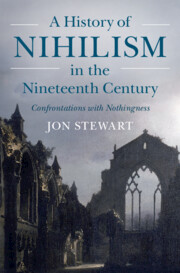Book contents
- A History of Nihilism in the Nineteenth Century
- A History of Nihilism in the Nineteenth Century
- Copyright page
- Dedication
- Contents
- Figures
- Preface
- Acknowledgments
- Introduction
- 1 Jean Paul’s Vision of Nihilism and Plea for the Doctrine of Immortality
- 2 Klingemann and the Absurdity of Nothingness in The Nightwatches
- 3 Nihilism in English Romanticism
- 4 Schopenhauer’s Theory of Human Suffering and Lack of Meaning
- 5 Büchner’s Account of the Reign of Terror as a Mirror of Human Existence
- 6 Poul Martin Møller’s Criticism of Hegelianism and the Danish Discussion of Nihilism
- 7 Kierkegaard and the Indefinability and Inexplicability of Death
- 8 Turgenev’s Portrait of a Nihilist
- 9 Nietzsche’s Vision of the Past and the Future of Nihilism
- 10 The Importance of Nihilism in the Nineteenth Century
- Selected Bibliography on Nihilism
- Name Index
- Subject Index
1 - Jean Paul’s Vision of Nihilism and Plea for the Doctrine of Immortality
Published online by Cambridge University Press: 10 March 2023
- A History of Nihilism in the Nineteenth Century
- A History of Nihilism in the Nineteenth Century
- Copyright page
- Dedication
- Contents
- Figures
- Preface
- Acknowledgments
- Introduction
- 1 Jean Paul’s Vision of Nihilism and Plea for the Doctrine of Immortality
- 2 Klingemann and the Absurdity of Nothingness in The Nightwatches
- 3 Nihilism in English Romanticism
- 4 Schopenhauer’s Theory of Human Suffering and Lack of Meaning
- 5 Büchner’s Account of the Reign of Terror as a Mirror of Human Existence
- 6 Poul Martin Møller’s Criticism of Hegelianism and the Danish Discussion of Nihilism
- 7 Kierkegaard and the Indefinability and Inexplicability of Death
- 8 Turgenev’s Portrait of a Nihilist
- 9 Nietzsche’s Vision of the Past and the Future of Nihilism
- 10 The Importance of Nihilism in the Nineteenth Century
- Selected Bibliography on Nihilism
- Name Index
- Subject Index
Summary
Chapter 1 explores the concept of nihilism in two works by the German writer Jean Paul. In “The Dead Christ Proclaims That There Is No God,” Jean Paul tries to follow the scientifically based denial of God to its logical conclusion to show that this leads to a horrifying view that no one can accept. In the work, Christ descends down to earth and declares that there is no God. A terrible scene of death and destruction follows, which provides a powerful image of nihilism. The rest of the chapter analyzes the novella The Valley of Campan. While “The Dead Christ” was concerned with refuting the denial of God, this work tries to refute the denial of the doctrine of immortality. A small group takes an excursion in the Valley of Campan in the Pyrenees, and they discuss the issue of immortality as they go. Each member of the group tries to convince the scientist Karlson of the truth of immortality, but he stubbornly refutes all their arguments. However, in the end he capitulates to the idea since he cannot bear the thought of the complete and final destruction of his beloved Gione. The argument is that it is impossible to live a happy life without belief in immortality.
- Type
- Chapter
- Information
- A History of Nihilism in the Nineteenth CenturyConfrontations with Nothingness, pp. 35 - 63Publisher: Cambridge University PressPrint publication year: 2023



